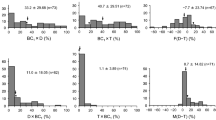Summary
A genetic analysis of the russet trait was made of 22 progenies from cultivated diploid parents. The observed segregation ratios fit a hypothesis of complementary action by three independently segregating dominant genes. No differences were found between reciprocal crosses. The genotypes of nine russet and eight nonrusset parents were determined.
Zusammenfassung
Rauhschaligkeit ist ein sehr gefragtes Merkmal bei Kartoffelzüchtungen in Nordamerika. Während der Dekade 1971–1980 waren 25% aller im American Potato Journal beschriebenen neuen Sorten rauhschalig. Neun stark rauhschalige und acht nicht rauhschalige, diploide Kulturkartoffelklone wurden als Eltern in einer genetischen Analyse des Rauhschaligwerdens bei 22 Nachkommenschaften gebraucht (Tabelle 1). Die beobachteten Aufspaltungsverhältnisse passten zu einer Hypothese der Komplementäraktion durch drei unabhängig aufspaltende, dominante Gene. Keine Unterschiede wurden zwischen reziproken Kreuzungen gefunden. Von allen 17 Eltern wurden die Genotypen bestimmt. Bei einem Merkmal, das von mehr als einem Gen kontrolliert wird, ist eine genetische Analyse auf tetraploidem Niveau sehr schwierig. Die Analyse demonstriert, wie eine grössere Verwendung von diploidem Keimplasma für die genetische Forschung eine zunehmende Menge von brauchbaren genetischen Informationen liefern und dadurch zukünftige Erfolge in der Kartoffelzüchtung erleichtern könnte.
Résumé
L'épiderme roux est une caractéristique très recherchée dans les cultivars de pommes de terre d'Amérique du Nord. Durant la décade 1971–1980, 25% des nouveaux cultivars décrits dans American Potato Journal ont l'épiderme roux. 9 clones de pommes de terre cultivés diploïdes fortement roussâtres et 8 non roussâtres sont utilisés comme parents dans une analyse génétique pour ce caractère sur 22 descendants (tableau 1). Les proportions de ségrégation observées s'ajustent à l'hypothèse d'une action complémentaire de 3 gènes dominants indépendants. Aucune différence n'est trouvée entre croisement réciproque. Les génotypes des 17 parents sont déterminés. Dans un caractère qui est contrôlé par plus d'un gène, une analyse génétique au niveau tétraploïde est très difficile. Cette analyse démontre comment une plus grande utilisation des protoplasmes diploïdes pour des recherches génétiques pourrait fournir une quantité importante d'informations génétiques utilisables, et ainsi faciliter la réalisation future d'hybridation sur la pomme de terre.
Similar content being viewed by others
References
Asseyeva, T. V. & I. M. Yashina, 1972. Somatic mutations in the potato.Soviet Genetics 4 (3): 386–404. Translated fromGenetika 4 (3) (1971): 145–164.
Clark, C. F., 1933. Further studies of the origin of russeting in the potato.Am. Potato J. 10: 88–91.
Clark, C. F., F. J. Stevenson & L. A. Schaal, 1938. The inheritance of scab resistance in certain crosses and selfed lines of potatoes.Phytopathology 28: 878–890.
Hougas, R. W. & S. J. Peloquin. Tetrasomic inheritance in the potato as related to the detection of ‘new’ genes and the synthesis of genetic tester stocks. Unpublished.
Howard, H. W., 1970. Genetics of the potato,Solanum tuberosum. Logos Press, London, pp. 126.
Pavek, J. J., 1980. Studies on the russet-skin character in potato. Progress Report to the North Central Region — 84 Potato Genetics Technical Committee Meeting. 2–3 Dec. 1980, Chicago.
Rieman, G. H., D. C. Cooper & D. A. Young, 1955. The Hindenburg russet character in relation to scab.Am. Potato J. 32 (11): 426.
Swaminathan, M. S. & H. W. Howard, 1953. The cytology and genetics of the potato (Solanum tuberosum) and related species.Bibliographia Genetica 16: 1–192.
Author information
Authors and Affiliations
Rights and permissions
About this article
Cite this article
De Jong, H. Inheritance of russeting in cultivated diploid potatoes. Potato Res 24, 309–313 (1981). https://doi.org/10.1007/BF02360368
Accepted:
Issue Date:
DOI: https://doi.org/10.1007/BF02360368




